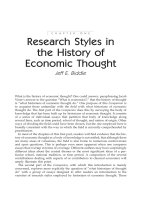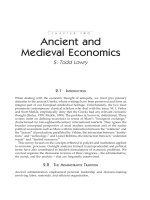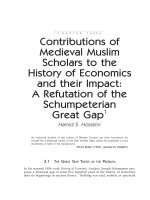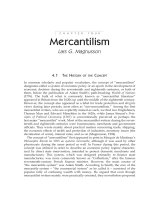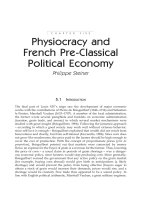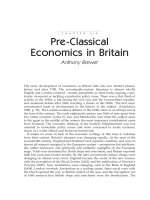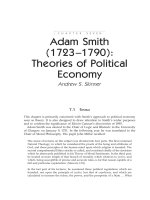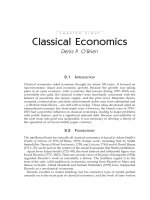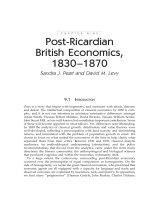A Companion to the History of Economic Thought - Chapter 18 pdf
Bạn đang xem bản rút gọn của tài liệu. Xem và tải ngay bản đầy đủ của tài liệu tại đây (204.92 KB, 16 trang )
278 D. A. WALKER
CHAPTER EIGHTEEN
Early General
Equilibrium
Economics: Walras,
Pareto, and Cassel
Donald A. Walker
18.1 LÉON WALRAS
18.1.1 Background
Walras, the founder of the modern theory of general economic equilibrium, was
born on December 16, 1834 in Evreux, France, and christened Marie Esprit Léon.
Despite his lack of formal credentials in economics, he obtained an appointment
at the Academy (subsequently University) of Lausanne in 1870, and remained
there for his entire career. He retired in 1892, and died on January 5, 1910 in
Clarens, Switzerland (for biographical information, see Jaffé, 1935: for biblio-
graphical information, see Walker, 1987; A. and L. Walras, 1987– ).
18.1.2 Walras’s mature comprehensive model
COMPETITION
Walras was the first economist to construct a complete general equilibrium model,
the mature comprehensive model set forth in the second edition of the Eléments
(1889). It is called “comprehensive” because it encompasses exchange, production,
consumption, capital formation, and money; and “mature” to differentiate it
from the models in the first and fourth editions. In that model, Walras not only
EARLY GENERAL EQUILIBRIUM ECONOMICS 279
expressed the belief that all economic phenomena are interrelated, which had been
done by many economists before him, he also specified their interrelations, studied
their disequilibrium behavior, and described their conditions of equilibrium.
One of Walras’s fundamental methodological convictions was that the assump-
tions of a theory must be drawn very carefully from empirical reality (1896b, p. 10),
and one of his principal objectives as an economic theorist was to understand
the behavior of the markets that functioned in the economy of his time. His study
of empirical reality convinced him that “free competition in regard to exchange is
the almost universal regime” (Walras, 1965, vol. 2, letter 999, pp. 434–5), “practiced
on all markets with more or less precision and therefore with less or more frictions”
(Walras, 1895, p. 630), and so he drew the assumption of a purely competitive
economy from the real economy. That is why he constructed a general equilib-
rium model of a freely competitive economy; not, as has been suggested (Jaffé,
1977), in order to design a utopia whose conditions necessitated the operation of
that type of system. The specific type of real market from which he drew some
characteristics was a freely competitive organized market, like a stock exchange
or a wholesale market for an agricultural commodity (Walras, 1988, §41, pp. 70–
1, cited because this is a variorum edition, with section numbers that enable the
reader to find the passage in the 1954 English translation). In such markets, prices
are determined by the forces of supply and demand without collusion and are
changed by buyers and sellers in the same direction as the sign of the market
excess demand (1988, §42, pp. 71–2), which is what Walras meant by the term “free
competition.” That feature, he contended, was also sufficiently true of unorganized
competitive markets that the workings of free competition and its consequences
can be attributed to them also (1988, §41, pp. 70–1). Regarding competition, he had
“as a first step, reduced that mechanism to its essential elements.” Subsequent steps
should be taken, he argued, to create a progressively more realistic model, namely
one infused with additional empirically derived conditions: “it is appropriate to
introduce into [my] model one by one all the complications that reality presents”
(1894, p. 624). Thus his general equilibrium model, he declared, was “not only
the idea but the image” (1896a, pp. 469–70) of the real economy of his time.
MARGINAL UTILITY THEORY
Another of the fundamental building blocks of Walras’s general equilibrium model
is his idea of marginal utility and the maximization of total utility by each parti-
cipant. Those concepts provided a motive for economic behavior and a condition
of equilibrium, elements that were essential for the functioning of his model of
general equilibrium. Instead of confining the marginal utility theory to the inves-
tigation of consumption and of simple exchange, Walras went far beyond the
work of its other initiators by using it to analyze the behavior in multiple markets
of a variety of participants undertaking different economic functions. In his model
of consumer behavior (1988, §74, p. 107; §75, p. 111; §80, p. 116), Walras assumed
that the utility a consumer derives from any commodity is independent of the
amount he or she consumes of other commodities, that utility is cardinally meas-
urable, and that each individual’s demand for a commodity is, in principle, a
function of the prices of all commodities. A consumer efficiently maximizes total
280 D. A. WALKER
utility by buying the quantity of each commodity that makes the utility received
from the expenditure of a unit of money on it equal for every commodity pur-
chased. Likewise, in Walras’s models, professional traders and wholesale and
retail merchants add to their holdings of each commodity, or sell out of their
stocks of commodities, until they hold the batch of commodities that maximizes
their utility. Entrepreneurs and capitalists strive to maximize utility by maximizing
their profit and interest incomes respectively (1988, §188, p. 284).
EQUILIBRIUM IN THE MATURE COMPREHENSIVE MODEL
Walras studied the existence, uniqueness, and stability of general equilibrium in
his model. He thought that he had proved that an equilibrium exists in it because
he had described it with as many equations as there are unknowns (for example,
1988, §205, pp. 306–7). He then undertook a comparative static analysis in order
to analyze how the solutions to the equations are affected by arbitrarily postu-
lated or exogenously induced changes of their parameters, such as preferences,
the quantity of money, and the quantity of a commodity held by the participants.
Walras’s proof was not valid, however, because he did not take account of the
effect of disequilibrium processes on phenomena that are parameters in the
equations, and because he did not establish that the solutions to the equations are
economically admissible, as will be explained at the end of this essay. Nevertheless,
his examination of the question went far beyond the analyses of other nineteenth-
century economists, inasmuch as he dealt with a model of general rather than
particular equilibrium. His study of uniqueness was limited to the consideration
of isolated markets and a multi-market model of pure exchange, and his conclusion
that “generally” multiple equilibria do not occur in the latter case was a statement
rather than a proof (1988, §156, pp. 242–3).
DISEQUILIBRIUM BEHAVIOR IN REALITY AND IN THE MODEL
The basis of Walras’s theoretical work on stability was his conception of the
real economy as always undergoing processes of change (1988; §322, pp. 579–80).
The disequilibrium adjustments, Walras maintained, continually move the real
economy toward a position of general equilibrium. He called them the process of
“tatonnement,” a word that means “reiterated hesitant groping movements to
find something.” Walras set himself the task of modeling that behavior (Walras,
1965, vol. 2, letter 927, p. 364). Presenting his initial results in the years 1874–7,
he thus became the first economist to study the stability of a general equilibrium
model (1895, p. 630).
On every market day in the model, transactions of any particular commodity
occur only at the price at which the supply and demand quantities are equal.
Walras knew that was not true in many real markets, but believed that it was a
“hypothesis that no scientific mind will hesitate to concede to the theoretician”
(1895, p. 630). After attainment of that price, the market day in his model is
nevertheless in disequilibrium if the price and the average cost of production of
the commodity are not equal, or if the participants are affected by the prices
subsequently determined in other markets. The aspect of the model’s tatonnement
that takes place with respect to new quantities manufactured is the progressive
EARLY GENERAL EQUILIBRIUM ECONOMICS 281
diminution of the difference between price and average cost of the product as a
result of the changes of the price in the output market and of the prices of inputs.
The rate of output in each industry is changed in the same direction as the sign of
that difference. The aspect that takes place with respect to sales of each commod-
ity is the progressive diminution of the difference between the quantity supplied
and the quantity demanded. The price is changed in each market in the same
direction as the sign of the excess demand quantity. “The system of new quant-
ities manufactured and new prices . . . is closer to equilibrium than the previous
one, and it is necessary only to continue the tatonnement in order to approach it
more and more closely” (Walras, 1889, p. 241). In equilibrium, “prices are those
at which the quantities demanded and supplied of each service or product are
equal, and for which, moreover, the price of each product is equal to its average
cost of production” (1988, p. 13). The mutually determined sets of prices, average
costs, and quantities supplied and demanded are harmonious and fulfill the
plans of all the participants in the model.
THE ENTREPRENEUR
Walras believed that entrepreneurs undertake essential functions in the real eco-
nomy and therefore accorded them a role of crucial importance in the dynamic
behavior of the mature comprehensive model (Walras, 1965, vol. 2, letter 800,
p. 212). Entrepreneurs lead it to equilibrium. Walras portrayed them as relating
input and output markets by buying labor, land services, capital-goods services,
and raw and semi-finished goods, combining them to produce consumer com-
modities or capital goods, and selling them (1988, §189, pp. 287–8). One connection
between input and output markets is established by the entrepreneur through
the circumstance that the average cost of production is determined on the input
side of the market and is an important part of the price charged on the output
side. Entrepreneurs make a profit, which is their remuneration, as long as aver-
age cost is less than price and a loss in the opposite case. They adjust production
from one disequilibrium rate to another, thereby altering average cost and price
until they become equal. Profit is then zero and a state of equilibrium obtains
(1988, §189, pp. 194–7). Another connection between input and output markets
established by the entrepreneur is that they pay incomes to the owners of the
economic resources that they hire and those incomes are spent by their recipients
on consumer commodities and capital goods (1988, §§185–6, pp. 281–2).
CAPITAL FORMATION
Walras’s treatment of savings and investment (1988, §§241–2, pp. 357–63) reveals
yet another way in which entrepreneurs connect different economic sectors and
markets. The incomes paid to owners of economic resources by entrepreneurs
are partially saved by the recipients in their role as members of households, in
which connection Walras formulated the first macroeconomic savings function. He
developed a model of processes by which capitalists transfer their money savings
to entrepreneurs through purchasing stocks and bonds (1988, §269, pp. 434–6),
and explored those processes in studies of credit markets (1898, pp. 307–36). Walras
showed how the capital goods that the entrepreneurs produce are priced and
282 D. A. WALKER
employed in the most profitable uses. He likewise constructed a model of the
determination of the rate of net income generated by the use of capital goods,
and of the determination of the market and equilibrium rates of interest (1988,
§§231–71, pp. 345–436).
WELFARE ECONOMICS
Walras enunciated the principle of consumer sovereignty and modeled the way in
which it operates to determine the set of commodities that are produced. The entre-
preneur transmits the desires of consumers to the production side of the market,
thus allocating resources so that the set of commodities produced is in accordance
with the structure of consumer demands and hence reflects consumer preferences
and purchasing power (1988, §188, pp. 283–4). On the basis of that analysis, Walras
developed a thesis that became a central issue in the study of welfare economics,
namely that free competition tends to generate a maximum of well-being for society
(1988, §221, p. 334; §264, p. 424). The maximum is a relative one, because it depends
upon the distribution of income and wealth and the dynamic characteristics of the
model that result in it moving toward a particular set of equilibrium values. He
emphasized that the maximum results from actions by economic agents to maxim-
ize utility, the establishment of a set of prices that equalizes supply and demand,
the sovereignty of the consumer, and the other features of a competitive economy
that he put into his model. The theory makes clear that “the mechanism of free com-
petition leads precisely to the solution by tatonnement of this system of equations;
from which it follows that the mechanism creates maximum satisfaction” (Walras,
1965, vol. 2, letter 928, pp. 364–5; and see Walras, 1988, §264, p. 424).
18.1.3 The written pledges sketch
The problem for Walras’s exposition is that the equations that he wrote out have
parameters that are actually endogenous variables in the tatonnement process in
his model. He explained that production and exchange occur in disequilibrium
in the mature comprehensive model, varying as prices change during the course
of the adjustment of the markets toward their equilibrium set of variables (see,
for example, 1889, pp. 235, 238, 294; 1988, §§209–12, pp. 315–19, §258, pp. 399–
401). The phenomena that change as a result include the asset holdings of the
participants, which alter as a function of the variations in hiring, production and
sales that occur as entrepreneurs adjust levels of output in order to maximize
profits; and they include the amounts of each type of capital good, which vary in
accordance with changes in the amount and composition of investment, which
in turn varies with changes of the prices, costs, and incomes of capital goods,
and with the rate of interest and changing levels of saving. Other variables that
are affected are the incomes of the participants. Since consumer demand func-
tions depend on both asset holdings and income, they also change during the
tatonnement. Consequently, the equations that Walras presented as relating to
the mature model of general equilibrium do not in fact describe it. Their solu-
tions – prices, rates of employment of resources, incomes, outputs, and quantities
traded – are not the values toward which the model actually converges.
EARLY GENERAL EQUILIBRIUM ECONOMICS 283
In 1899 and in the fourth edition of the Eléments (1900), Walras tried to design
a virtual model that would eliminate this problem, thus abandoning his objective
and method of trying to construct a realistic model. A virtual model is one in
which no economic activities occur in disequilibrium, except for the quotation of
prices and the manifestation of the associated desired supply and demand quan-
tities. In that way he hoped that the parameters of his equations would represent
conditions that are truly constant during the equilibrating process of his model.
He thought that he could achieve the virtual property by assuming that suppliers
of resources and other commodities do not produce disequilibrium amounts but,
instead, make written pledges to provide the commodities. Walras stated that
they vary the amounts offered as a function of a series of suggested prices until
the set is found at which the desired supply and demand of every commodity
become simultaneously equal in every market. Only then are other economic
activities allowed to take place (1900, pp. VIII, 215, 224, 260, 298, 302; 1988, pp.
5–7, §§207, 213–14, 251, 273, 274; pp. 309, 323, 377, 441, 447). The written pledges
construction, however, is an incomplete sketch, notably because would-be
demanders of consumption goods do not make pledges and so have no means of
expressing their desires (Walker, 1996, pp. 372–95). Of course, Walras asserted
that there is a tatonnement and that equilibrium is found, but those were just
unsupported statements, not a consequence of his assumptions, not an outcome
of the structure of the sketch and the behavior of its participants. Furthermore, he
did not carry out his plan (1900, p. VIII; 1988, pp. 5, 7) to convert into written
pledges markets all the older sub-models that are supposed to play a role in the
1899 design – sub-models dating from his mature period of theorizing but that he
left unchanged in the fourth edition of the Eléments. He therefore presented
disequilibrium production and exchange as occurring in some markets but not in
others, a situation contradicted by his equation system, which allows only for
virtual behavior. Thus Walras did not construct a general equilibrium model
in his last phase of theorizing. Neither the written pledges sketch alone, nor it
and the collection of sub-models associated with it, contain a pricing process or
any other economic activities. It does not constitute a functioning system and
therefore has no dynamic path and no equilibrium.
Nevertheless, by 1889 Walras had a fully formed conception of the interrelat-
edness of economic phenomena and well-constructed sub-models of the import-
ant parts of a competitive economic system. The vitality of those contributions to
economic theory was manifested by the strength of their influence on Vilfredo
Pareto, to whose ideas we now turn.
18.2 VILFREDO PARETO
18.2.1 Background
Vilfredo Pareto’s ideas are presented in this essay because he was, after
Walras, the second most important economist in the early development of the
theory of general equilibrium. Pareto was born on July 15, 1848 and christened
284 D. A. WALKER
Federico-Vilfredo-Damaso. In the early 1880s he became interested in the applica-
tion of mathematics to economic theory and policy formulation. Because of that
approach (Walras, 1965, vol. 2, letter 1126, n. 3, pp. 553–4), and recommendations
by Maffeo Pantaleoni and Walras, he was offered the position that Walras had
held at the University of Lausanne and began his duties there in 1893. In the
economic realm, he published his most important contributions in the Cours
d’économie politique (1896/1897), Manuale d’economia politica (1906, 1909), and
“Economie mathématique” (1911). After 1905, Pareto concentrated upon sociology.
He retired in 1911, but continued making contributions to social science (see Pareto,
1963–2001). He died on August 19, 1923 (for biographical and bibliographical
information, see Busino, 1987; Kirman, 1987).
18.2.2 The general equilibrium model
Walras’s mathematical method and his conception of a multi-market competitive
economy, of its equilibrating processes, and of general equilibrium, were
extremely important in Pareto’s economic reasoning (Walras, 1965, vol. 3, letter
1489, p. 154). He used Walras’s mathematical form of expression of supply and
demand, and regarded literary discussions of them as being useless and foolish
(Pareto, 1909, ch. III, §181, p. 220). Pareto improved Walras’s mature comprehen-
sive model in some respects, and developed his own original theories. He agreed
with Walras that the scope of pure economic theory is limited to facts and
relationships regarding which free will does not play a part. He believed that
the methods of positive science should be used in the study of all aspects of eco-
nomics and of human behavior generally. Like Walras, he thought that the
assumptions of a theory should be realistic (1916/1963, pp. 28–30). Inferences
from them, he argued, should be evaluated by empirical studies, because “theories,
their principles, their implications, are altogether subordinate to facts and possess
no other criterion of truth than their capacity for picturing them” (1916/1963,
p. 30). He also espoused the method of successive approximations of theory to the
real economy, by which he meant the progressive introduction into a model
of empirically derived considerations so as ultimately to achieve a high degree
of realistic detail (1896/1897, vol. 1, pp. 16–17; vol. 2, pp. 15, 78).
THE THEORY OF DEMAND
Pareto’s theory of consumer demand is a central pillar of his model of general
equilibrium. He may have thought that it is not impossible, in principle, to measure
utility objectively (see Kirman, 1987, p. 805), but he nevertheless observed that no
one has “been able to succeed in demonstrating that pleasure can be measured,
that it is a quantity, nor above all to discover how one could go about measuring
it” (Pareto, 1909, appendix, §137, p. 661). He therefore made the important inno-
vations of assuming that utility is ordinally measurable, the consumer being able
to specify that he prefers one batch of commodities to another or is indifferent
to them (1909, ch. III, §52, pp. 168–9), and of showing that his demand function
can nevertheless be derived. Pareto also assumed that the utilities of different
commodities are not independent. Some commodities are substitutes for each
EARLY GENERAL EQUILIBRIUM ECONOMICS 285
other, he noted, and others are complements (1909, ch. IV, §§12–14, pp. 253–56).
Using calculus, Pareto then formulated a theory of consumer demand based on
the Walrasian assumptions that the consumer wants to maximize his utility and
knows how to do so, and that the quantity he demands of a commodity is a
function of the prices of all consumer commodities, given his income and prefer-
ences (1896/1897, vol. 1, p. 35). Pareto also affirmed Walras’s conclusion that the
consumer achieves maximum utility by purchasing the amounts of any two
commodities for which the ratio of their marginal utilities is equal to the ratio of
their prices, although Pareto expressed that condition in the way appropriate for
an ordinal indifference analysis (1909, appendix, §24, p. 559). Pareto’s reformula-
tion of Walras’s model of consumer behavior was adopted by many continental
economists and was developed into the modern theory of consumer demand.
THE EXISTENCE, UNIQUENESS, AND STABILITY OF EQUILIBRIUM
Like Walras, Pareto used a set of simultaneous equations in an effort to describe
the characteristics of his model of general equilibration and equilibrium of a
competitive economy, with the difference that he constructed a completely
disaggregated version in which there is an equation for each consumer, for each
resource supplier, and for each seller of output (1896/1897, vol. 1, pp. 44–61).
Pareto believed that the dynamized version of his model was highly realistic
(1897, p. 492). He asserted that equilibrium exists in his model because the
number of independent equations equals the number of unknowns (1896/1897,
vol. 1, pp. 26, 44–6, 61), and then discussed how the economy moves toward it.
In this connection, Pareto had studied Walras’s attempts to show that his
mature comprehensive model is stable and he naturally took its dynamics as his
starting point – naturally, because that model, with all of its irrevocable
disequilibrium processes and phenomena, is the one presented in the edition of
the Eléments that Pareto studied in the 1890s. Pareto believed that the freely
competitive tatonnement process featured in that model accurately described the
disequilibrium behavior of the real market system. With respect to exchange,
he contended that “Walras has shown that the bargaining that takes place in
free competition is the means of solving the equations of exchange by repeated
attempts” (1896/1897, vol. 1, pp. 24–5). “M
r
Edgeworth has objected that that
is only one means” by which markets move toward equilibrium. “He is right,”
Pareto declared, “but the way indicated by M
r
Walras is truly the one that de-
scribes the largest proportion” of markets (1896/1897, vol. 1, p. 25). With respect
to production, he argued that Walras’s idea of tatonnement in that aspect of
economic activity should also be adopted, and for the same reason, namely that
it was an accurate description of what happened in the real economy: “M
r
Walras
has shown that the competition of entrepreneurs and traders is a means of solv-
ing the equations of the equilibrium of production through successive attempts.
This idea, in general, seems very fruitful for economic science” (1896/1897, vol. 1,
pp. 45–6). Pareto therefore used Walras’s mature concept of tatonnement in his
formulations of competitive economic adjustments in the 1890s, and he did not at
any time pay any attention to the written pledges sketch. He made a minor
addition to the analysis of what he called multiple equilibria by arguing that
286 D. A. WALKER
consumers might choose consumption patterns that lead them to the equilibrium
that is best for them (1909, ch. III, §§128–9, pp. 197–8).
THE ENTREPRENEUR
Pareto followed Walras in arguing that speculators transmit price signals to the
production side of the economy by buying or selling in response to price changes,
and that they facilitate the process of transforming savings into new capital goods
(Walras, 1880, pp. 370, 379; Pareto, 1896/1897, vol. 2, pp. 242–5). “The social
function of speculators, insofar as they do not act directly on prices, is to solve
the equations of economic equilibrium in the best and promptest manner poss-
ible” (Pareto, 1896/1897, vol. 2, p. 245). For the case of free competition, Pareto
adopted Walras’s theory of the entrepreneur, agreeing that their actions would
lead to an equilibrium in which economic profits are zero. He extended the
analysis of how entrepreneurs behave in the phase of disequilibrium, however,
in two major ways. First, they make errors in their production decisions:
It is necessary to produce commodities during a certain period of time – sometimes
a very long time – before they are consumed. In order for there to be a perfect
adaptation of production to consumption it would be necessary: 1° that consumer
demand be predicted; 2°
that the results of the process of production be accurately
predicted. It is impossible to do these two things with precision. (1909, ch. IX, §76,
p. 530)
The entrepreneurs try to correct their errors by changing production levels
during the equilibrating phase of the economy. Secondly, entrepreneurs keep
changing their profit goals, thereby repeatedly modifying the path taken to
equilibrium, and as a result the equilibrium values of the variables change (1909,
ch. V, §11, p. 289; §§74–5, p. 331). Thus, according to Pareto, path dependency
results from disequilibrium transactions and disequilibrium production not only
because they change the total amount of commodities and their distribution dur-
ing the equilibrating process – causes of path-dependency in Walras’s model –
but also because of errors and revisions of expectations and plans on the part of
the entrepreneurs (1896/1897, vol. 1, pp. 18–19).
Pareto also examined the behavior of firms in markets in which there is a lack
of adequate competition. In that event, he noted, there is no tendency to reduce
the profits made by an entrepreneur to zero. That gave rise to his analysis of a
monopolistic entrepreneur who is able to restrict output and thereby to charge a
price for his product that is greater than its average cost, which he would not be
able to do if he were in a competitive industry (Pareto, 1896/1897, vol. 1, pp. 62–
9, passim). Like most economists, Pareto argued that private monopolies are
obstacles to an optimum allocation of resources and to efficient rates of their use.
“It is easy to see that in all cases the monopolist’s profit is obtained only by harm-
ing others” (1896/1897, vol. 1, p. 69).
Entrepreneurs are the central agents in Pareto’s theory of production. He
argued that some entrepreneurs choose a technology with variable coefficients of
production and other choose one with fixed coefficients. He included both types
EARLY GENERAL EQUILIBRIUM ECONOMICS 287
in his theory of marginal productivity, thus producing a sophisticated version
(1896/1897, vol. 2, pp. 84–90).
WELFARE ECONOMICS
Pareto supported the thesis that free competition generates a relative maximum
of welfare for a society, and he sharpened the definition of that situation by
stating that the “members of a group enjoy, in a certain state of the economy, a
maximum of utility when . . . a small change . . . is agreeable to some, disagreeable
to others” (1909, ch. VI, §33, p. 354); in other words, when it is impossible to make
anyone better off without making someone worse off. Pareto also developed
propositions about the welfare aspects of production and consumption of
consumer commodities that were similar to Walras’s theorem on the maximum
utility of new capital goods (Walras, 1889, pp. 301– 7; 1988, pp. 417–25). As a
result of these formulations, Pareto became the first theorist to demonstrate,
subject to various conditions, that a state of maximum efficiency can be achieved
by an economy of the type that Walras described in his model. Pareto’s formulation
became the foundation of the “new welfare economics,” which is the modern
study of maximum efficiency and well-being. In recognition of his contribution,
the optimum condition that he identified is known as a Pareto optimum.
Pareto’s analysis of economic efficiency was powerful and general because he took
account of the conditions for maximum efficiency in markets for all types of com-
modities, and in exchange, production, consumption, and capital formation. One of
his notable contributions in this regard was to distinguish between the conditions
for maximizing individual welfare and the conditions for maximizing the welfare
of society as a whole. He showed that earlier economists sometimes erroneously
assumed that because an individual can reach a higher level of well-being when he
acts alone, all individuals can do so when they act simultaneously. In particular, he
noted that if national income is constant, one person may be able to increase his
welfare by acquiring more income, but all individuals obviously cannot do so.
Those who believe that the distribution of income should be changed have not
been pleased with Pareto’s law regarding it. He developed an equation that he
believed describes the general aspects of the distribution of income in many
different economies and times, showed the goodness of fit of the equation to the
data for some economies, and concluded that the “distribution of income is not
the effect of chance” (1897, p. 315). He argued that there are underlying laws of
production and of the use of economic resources that cause the distribution
of income to take that general form, thereby casting doubt on the possibility of
altering the distribution of income by government policies. Even if it were true,
however, that the functional distribution of income is largely unchangeable, Pareto
should not be understood as implying that the personal distribution of income
cannot be affected by taxes and transfer payments.
18.2.3 General socioeconomic equilibrium
Pareto’s sociology was not an abandonment of economic analysis, but an attempt
to provide a broad perspective which would enable a better comprehension of
288 D. A. WALKER
how the economy fits into the totality of human life, and which would therefore
provide a better understanding of how the various aspects of social life must be
taken into consideration in the formulation of policies which concern economic
matters. He tried to show (1916) that, as most scholars have known, just as there
are interconnections between economic variables, so also are there interconnec-
tions between noneconomic variables, and between them and the economic ones.
Influenced by Auguste Comte’s idea of a unified social science and by Herbert
Spencer’s application of Darwinism to an explanation of the development of
civilizations, Pareto’s objective was to achieve a theory of the general equilibrium
of society as a whole. He was not able, however, to achieve a satisfactory syn-
thesis of the diverse materials that enter into the problem. In particular, he
was unable to show that a society tends to move toward a certain equilibrium
configuration in its class relations, its judicial system, its political system, and so
on, as well as toward an equilibrium of the economic variables in the manner
described by Walras. The goal that he set himself was not only too ambitious for
one scholar to attain but probably impossible, not just because of the great changes
in fundamental conditions that continually occur, but because it is by no means
clear – and certainly has never been demonstrated – that society as a whole is an
equilibrating system. That should not diminish appreciation of the magnitude
of Pareto’s achievement in pointing out the many respects in which economic
activities and the other aspects of private and social life are interrelated.
18.3 KARL GUSTAV CASSEL
18.3.1 Background
Karl Gustav Cassel is grouped with Walras and Pareto in this essay because he
was also an important early general equilibrium theorist and because his work
on general equilibrium is a lineal descendant of that of Walras. He was born in
Sweden on October 20, 1866, attended Uppsala University and the University of
Stockholm, and was appointed Professor of Economics and Financial Science
at the latter institution in 1904. In addition to his work on general equilibrium,
he contributed to the theory of interest and capital (1903), and his achievements
in quantitative economics established his position as an exceptionally capable
early econometrician (1935). He died on January 15, 1945 (for biographical and
bibliographical information, see Myrdal, 1945; Gustafsson, 1987).
18.3.2 General equilibrium theory
APPROACH AND COMPONENTS
Cassel’s approach to economics was consistently one of general equilibrium ana-
lysis. He disagreed, however, with a number of the components of the models
that Walras and Pareto had developed. He rejected the marginal utility theory
of value, whether based on cardinally or ordinally measurable utility (1918, p. 81).
He argued that since the amount of commodities consumed could not be known
EARLY GENERAL EQUILIBRIUM ECONOMICS 289
until the set of equilibrium prices and quantities is determined with the use of a
general equilibrium system of equations, the marginal need that is satisfied, and
therefore the marginal utility to each consumer, could not be known until that set
is determined. He concluded that “What we call ‘marginal utility’ – if we now
wish to introduce this conception – thus occupies exactly the same place as an
unknown in the problem as does price, and it is therefore obviously absurd to
cite ‘marginal utility’ as a factor explaining price” (1932, p. 147). In place of that
concept, Cassel wanted to substitute the principle of scarcity, in response to
which Knut Wicksell commented that something is scarce
. . . only in relation to wants, or to the extent it becomes an object of demand. And
the degree of scarcity is measured in exactly the same way as marginal utility, by
the strength of the next unsatisfied need, which first causes the commodity to be
recognized as “scarce.” In other words, scarcity and marginal utility are funda-
mentally one and the same thing. (Wicksell, 1934 [1918], p. 221)
Instead of using utility theory, Cassel assumed in his model of general equilib-
rium that demand functions are primitive constructions, which has led many
commentators to declare that he anticipated revealed preference theory. Paul
Samuelson (1993) has firmly rejected that view, arguing that Cassel instead had a
“revealed demand” approach, which seems a reasonable assertion inasmuch as he
denied the value of regarding demand functions as expressive of underlying
preference functions.
Cassel did not accept the Walras–Pareto doctrine that maximum satisfaction is
obtained by a perfectly competitive economy, arguing that large-scale enterprises
are much more efficient than small-scale ones, but are “absolutely incompatible”
with free competition (1932, p. 129). Moreover, competition generates monopoly;
it brings “into being its own antithesis,” so “to take free competition as the
starting-point for a general theory of prices is of very little use” (1932, p. 129). He
thought that in most production processes the factors of production are indivis-
ible, or that it is very often impossible to use less of one factor without throwing
the others out of work (1932, p. 179). In his equation system, he consequently
adopted the assumption of technologically fixed coefficients of production, which
is incompatible with the Walras–Pareto theory of marginal productivity in which
at least some of those coefficients are variable, while suggesting in his literary
account that substitution among factors is possible (1932, pp. 179–81).
Nevertheless, Cassel used Walras’s conception of general economic equilib-
rium as a basis for his work, and carried a number of the specific constructions of
Walras and Pareto forward in the stream of economic studies. His general equilib-
rium models were inferior to those of Walras and Pareto, for reasons that will
be made clear, but they nonetheless made an original contribution to the subject.
Moreover, his formulation was very influential. This was in large measure
because his exposition was much more comprehensible than that of Walras, a
feature that it owed to its highly simplistic character, and because he published it
in German, the language spoken and written by the important continental gen-
eral equilibrium theorists in the 1930s. The work of Walras and Pareto was not
290 D. A. WALKER
widely known, whereas Cassel’s text, in German or English, was used in European
universities and was considered to be the definitive statement of general equilib-
rium theory. It was standard reference material for the mathematicians and econo-
mists who were members of the Vienna Colloquium in the 1930s (Weintraub, 1983),
becoming the starting point for the investigations of the existence of equilibrium
undertaken by Karl Schlesinger and Abraham Wald. It was a stimulus to the
work of John von Neumann on general equilibrium and, although of far less
importance than the ideas of Walras and Pareto to J. R. Hicks, it was studied by
him in either German, which he could read, or the English translation.
CASSEL’S THREE MODELS
Cassel presented three models using Walras’s general equilibrium approach, which
have consequently become known as Walras–Cassel models. The first was a
model of pure exchange with fixed available amounts of the commodities (1932,
pp. 138–40). Cassel constructed a demand function aggregated over all demanders
for each commodity, the quantity demanded being a function of all prices.
For each commodity, he set the demand function equal to the fixed supply and
declared that there is an equilibrium set of prices because there are as many
equations as unknowns. Inasmuch as the money expenditures of the consumers
are given, absolute prices are determined. In the second, which he called a model
of the stationary state because the quantities of the commodities produced are
constant, Cassel assumed that the amounts of money to be spent by consumers,
the quantities of the factors of production, and the technical coefficients are given.
With great clarity and simplicity, he then constructed a system in which the
demand and supply for each commodity produced are equated and similarly for
each factor of production, and in which the output and the input sides of markets
are linked. He then dropped the assumption that the incomes and expenditures
of the consumers are given, and introduced equations that result from his identi-
fication of them as the owners of the factors of production. Their prices and
quantities, and hence the incomes of their owners, are determined as part of the
general equilibrium of an expanded system. In his third model, which he called a
model of the uniformly progressing state, Cassel was concerned not with a posi-
tion of equilibrium but with a path of growth, an interest that was probably
inspired by Walras’s investigation of some of the properties of a growing economy
(Walras, 1988, pp. 447, 575–80). Cassel’s reasoning and his exposition of this
model were essentially literary. He discussed the modifications that were neces-
sary to the equations of his second model and verbally deduced the consequences.
He assumed that the amounts of the reproducible factors of production increase
at a fixed rate (1932, pp. 152–5). As in the second model, they are always
fully employed. The prices of the factors and of consumer commodities remain
unchanged as the economy grows. Cassel deduced that exponential growth
occurs: the production of each commodity increases at that rate, as do money
incomes, demands, supplies, savings, investment, and consumption (1932, p. 153).
The model thus introduced the concept of steady-state growth. Anticipating
the Harrod–Domar model, it is an original early formulation of a multiplier–
accelerator process.
EARLY GENERAL EQUILIBRIUM ECONOMICS 291
THE CHARACTER AND LIMITATIONS OF THE MODELS
A serious limitation of Cassel’s general equilibrium models is that they are de-
void of behavioral content, and are therefore devoid of features, plausible or
otherwise, to which his equations could have reference. Walras’s and Pareto’s
models are vastly richer. They took pains to establish the institutions, proced-
ures, technology, rules, and pricing processes in the markets that they analyzed,
and only then did they try to describe many of those characteristics and their
outcomes with equations. Walras, for example, used 116 pages for his theory of
exchange alone. In contrast, Cassel used only 16 pages to present all three of his
models. He made no mention of the characteristics of markets or the behavior of
suppliers and demanders, offering no explanation of how prices are formed. His
models are even more highly idealized systems than Walras’s 1900 written pledges
sketch. That was a sketch of a virtual model, but Walras described it as having
disequilibrium states and, indeed, he introduced the device of written pledges
with the intention that the model would be virtual but would also have a process
of adjustments in disequilibrium that would lead it to general equilibrium. Cassel,
on the other hand, constructed models that are not only virtual but that, he
simply assumed, are always in equilibrium; they have no tatonnement process
because he assumed that they do not. That greatly simplified the models, and
therefore Cassel’s theoretical task, because he had no reason to examine the
questions of the existence of equilibrium or of stability, or whether or not there
are multiple solution sets of the variables. It also means, however, that he did not
provide any explanation of why his models should be considered theoretically
interesting or empirically applicable.
18.4 A SUMMARY OF EARLY GENERAL EQUILIBRIUM ECONOMICS
General equilibrium theory has had a complicated history. Walras created the
mature comprehensive model of general equilibration and equilibrium. It was a
nonvirtual system; that is, one in which there are irrevocable disequilibrium
transactions and disequilibrium production. He also created a sketch of a virtual
hypothetical economy. Pareto amended and elaborated upon the nonvirtual model,
replacing Walras’s aggregative functions with disaggregated ones. Cassel chose
to follow the virtual approach, added the assumption that the system is always
in equilibrium, reverted to the use of aggregative functions, and developed
a model of steady-state growth. Subsequently, some theorists used Cassel’s
assumption that the model is always in equilibrium, and John von Neumann
followed his lead by developing a virtual purely competitive steady-state growth
model which is also always in equilibrium, although with some different
assumptions about consumption and savings.
For many years and down to the present day, however, most theorists have
chosen to elaborate upon Walras’s virtual sketch of a purely competitive economy.
They have had one or another, or both, of two objectives. First, they wanted to
determine whether equilibrium exists in such a model and whether the solutions
sets are unique, realizing the incorrectness of the belief of Walras, Pareto, and
292 D. A. WALKER
Cassel that the existence of equilibrium is assured simply by the equality of the
number of equations and unknowns. It was recognized in the 1930s that because
of the use of free inputs, such as air, sunshine, and rainwater may be, Walras’s,
Pareto’s, and Cassel’s equations of general equilibrium must be modified to include
the possibility of zero prices, and that the solutions to the equations must be real
numbers and cannot include negative prices or quantities. Secondly, since Walras’s
sketch of the use of written pledges is manifestly flawed and unworkable, general
equilibrium theorists dispensed with his notion of written pledges and constructed
a tatonnement process conducted by a central authority, flagrantly misnamed an
“auctioneer.” That personage, who does not conduct any auctions, quotes prices
in all markets until he finds the set that would put them all simultaneously into
equilibrium, whereupon he allows economic activities to take place at that set.
John Maynard Keynes’s model was nonvirtual; its adjustments take place
through irrevocable disequilibrium economic activities. It was not in the general
equilibrium tradition, but it proved adaptable and assimilable to that tradition,
which led to the creation of many nonvirtual macroeconomic general equilibrium
models. In recent years many nonvirtual microeconomic general equilibrium
models have also been devised, with the parentage of Walras’s mature com-
prehensive model explicitly recognized by their creators (Walker, 2001, vol. 2,
part III). Its workings have therefore found a secure place in economic thought.
Similarly, Pareto’s model gave rise to a disaggregative approach used by many
economists, and especially to the new welfare economics, which was a central
part of the revival of neoclassical economics in the 1930s and 1940s. Subsequently,
Kenneth Arrow, Gérard Debreu, Frank Hahn, and other mathematical econom-
ists have used Walras’s ideas about a virtual purely competitive model, Pareto’s
ideas about efficiency, concepts taken from game theory, and the notion of a
central price-setter to develop the foundations of what has become known as the
neo-Walrasian strand of general equilibrium theorizing.
Bibliography
Busino, G. 1987: Pareto, Vilfredo. In Eatwell et al., op. cit., vol. 3, pp. 799–804.
Cassel, K. G. 1903: The Nature and Necessity of Interest. London and New York: Macmillan.
—— 1918: Theoretische Sozialökonomie. Leipzig: C. F. Winter.
—— 1932: The Theory of Social Economy, translated by S. L. Barron from the 5th German
edition. London: E. Benn. Reprinted New York: Augustus M. Kelley, 1967.
—— 1935: On Quantitative Thinking in Economics. Oxford: The Clarendon Press.
Eatwell, J., Milgate, M., and Newman, P. (eds.) 1987: The New Palgrave. A Dictionary of
Economics, 3 vols. London: Macmillan.
Gustafsson, B. 1987: Cassel, Gustav. In Eatwell et al., op. cit., vol. 1, pp. 375–7.
Jaffé, W. 1935: Unpublished papers and letters of Léon Walras. Journal of Political Economy,
43, 187–207.
—— 1977: The normative bias of the Walrasian model: Walras versus Gossen. Quarterly
Journal of Economics, 91, 371– 87.
Kirman, A. P. 1987: Pareto as an economist. In Eatwell et al., op. cit., vol. 3, pp. 804 –9.
Myrdal, G. 1945: Gustav Cassel in memoriam. Ekonomisk revy, 2, 3–13.
Pareto, V. 1896/1897: Cours d’économie politique, 2 vols, ed. G H. Bousquet and G. Busino.
Geneva: Librairie Droz, 1964.
EARLY GENERAL EQUILIBRIUM ECONOMICS 293
—— 1897: The new theories of economics. Journal of Political Economy, 5(4), 485–502.
—— 1909: Manuel d’économie politique, translated by Alfred Bonnet from the Italian Manuale
d’economia politica. Milan: Società Editrice Libraria, 1906. Reviewed and corrected by the
author, Paris: V. Giard & E. Brière. Translated by A. S. Schwier as Manual of Political
Economy. New York: Augustus M. Kelley, 1971.
—— 1911: Economie mathématique. In Encyclopédie des sciences mathématiques, vol. 1. Paris:
Teubner, Gauthier, Villars.
—— 1916: Trattato di sociologia generale, 4 vols. Florence: Barbera. Translated by A. Bongiorno
and A. Livingston as The Mind and Society; A Treatise on General Sociology. New York:
Dover, 1963.
—— 1963–2001: Œuvres complètes de Vilfredo Pareto, 31 vols, prepared under the direction
of G. Busino. Geneva: Droz.
Samuelson, P. A. 1993: Gustav Cassel’s scientific innovations: claims and realities. History
of Political Economy, 25(3), 515–27.
Walker, D. A. (ed.) 1987: Bibliography of the writings of Léon Walras. History of Political
Economy, 19(4), 667–702.
—— 1996: Walras’s Market Models. Cambridge, UK: Cambridge University Press.
—— 2001: The Legacy of Léon Walras, 2 vols. In Intellectual Legacies in Modern Economics,
series editor S. G. Medema. Cheltenham: Edward Elgar.
Walras, A. and Walras, L. 1987– : Œuvres économiques complètes [OEC], 14 vols, edited by
P. Dockès, P H. Goutte, C. Hébert, C. Mouchot, J P. Potier, and J M. Servet, under the
auspices of the Centre Auguste et Léon Walras. Paris: Economica.
Walras, L. 1874/1877: Eléments d’économie politique pure ou Théorie de la richesse sociale.
Lausanne: Imprimerie L. Corbaz & C
ie
; Paris, Guillaumin & C
ie
; Basle, H. Georg; 2nd
edn., 1889; 3rd edn., 1896a; 4th edn., 1900; 5th edn., 1926, translated by W. Jaffé as
Elements of Pure Economics or the Theory of Social Wealth. Homewood, IL: Richard D. Irwin,
1954. For a comparative edition, see Walras (1988), op. cit.
—— 1880: La bourse, la spéculation et l’agiotage. Bibliothèque Universelle et Revue Suisse,
85th year, 3rd period, 5 (March), 452–76; 6 (April), 66–107.
—— 1894: Note on his own work and on Vilfredo Pareto’s prepared for the latter’s
installation as professor at the University of Lausanne, in Walras (1965), op. cit., vol. 2,
pp. 624–5.
—— 1895: Enclosure to letter from Léon Walras to Vilfredo Pareto, January 9, in Walras
(1965), op. cit., vol. 2, pp. 628–32.
—— 1896b: Etudes d’économie sociale (Théorie de la répartition de la richesse sociale). Lausanne:
F. Rouge/Paris: F. Pichon. In Walras and Walras (1987– ) [OEC], op. cit., vol. 9, 1990.
—— 1898: Etudes d’économie appliquée (Théorie de la production de la richesse sociale). Lausanne:
F. Rouge/Paris: F. Pichon. In Walras and Walras (1987– ) [OEC], op. cit., vol. 10, 1992.
—— 1899: Equations de la circulation. Bulletin de la Société Vaudoise des Sciences Naturelles,
35(132), 85–103.
—— 1965: Correspondence of Léon Walras and Related Papers, 3 vols, ed. W. Jaffé.
Amsterdam: North-Holland.
—— 1988 [1874/1877]: Eléments d’économie politique pure ou Théorie de la richesse sociale, ed.
C. Mouchot. In Walras and Walras (1987– ) [OEC], op. cit., vol. 8.
Weintraub, E. R. 1983: On the existence of a competitive equilibrium: 1930–1954. Journal of
Economic Literature, 21(1), 1–39.
Wicksell, K. 1934 [1918]: Professor Cassel’s system of economics. In Lectures on Political
Economy, 2 vols, trans. E. Classen. London: Routledge and Kegan Paul; vol. 1, appendix
1, 219–57.

